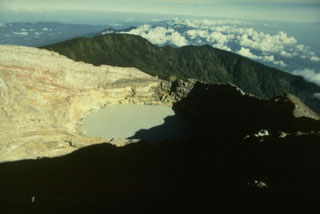Report on Dempo (Indonesia) — 22 May-28 May 2024
Smithsonian Institution / US Geological Survey
Weekly Volcanic Activity Report, 22 May-28 May 2024
Managing Editor: Sally Sennert.
Please cite this report as:
Global Volcanism Program, 2024. Report on Dempo (Indonesia) (Sennert, S, ed.). Weekly Volcanic Activity Report, 22 May-28 May 2024. Smithsonian Institution and US Geological Survey.
Dempo
Indonesia
4.016°S, 103.121°E; summit elev. 3142 m
All times are local (unless otherwise noted)
PVMBG reported that an eruption at Dempo occurred at 0406 on 27 May. A video posted with the report showed a Surtseyan eruption at the crater lake with dark material being ejected 300 m from the center of the lake. Dense white-and-gray ash plumes rose around 500 m and drifted W. According to a news report, the crater lake water had been changing colors during the previous few weeks. The color changed from turquois-green to gray and white on 9 May, and a diffuse gas-and-steam plume was visible. A seismic signal indicating an emission was recorded at 1911 on 12 May. The water turned turquois-green again on 15 May and then to gray on 17 May. The Alert Level remained at 2 (on a scale of 1-4), and the public were reminded to stay 1 km away from the crater and as far as 2 km on the N flank.
Geological Summary. Dempo is a stratovolcano that rises above the Pasumah Plain of SE Sumatra. The andesitic complex has two main peaks, Gunung Dempo and Gunung Marapi, constructed near the SE rim of a 3-km-wide amphitheater open to the north. The high point of the older Gunung Dempo crater rim is slightly lower, and lies at the SE end of the summit complex. The taller Marapi cone was constructed within the older crater. Remnants of seven craters are found at or near the summit, with volcanism migrating WNW over time. The active 750 x 1,100 m active crater cuts the NW side of the Marapi cone and contains a 400-m-wide lake at the far NW end. Eruptions recorded since 1817 have been small-to-moderate explosions that produced local ashfall.
Sources: Pusat Vulkanologi dan Mitigasi Bencana Geologi (PVMBG, also known as CVGHM), Antara News

